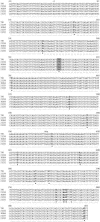Mechanisms of azole resistance in a clinical isolate of Candida tropicalis
- PMID: 16251302
- PMCID: PMC1280149
- DOI: 10.1128/AAC.49.11.4608-4615.2005
Mechanisms of azole resistance in a clinical isolate of Candida tropicalis
Abstract
Azole resistance has been insufficiently investigated in the yeast Candida tropicalis. Here we determined the molecular mechanisms responsible for azole resistance in a clinical isolate of this pathogenic yeast. Antifungal susceptibility testing performed by a disk diffusion method showed resistance or markedly decreased susceptibility to azoles, which was confirmed by determination of MICs. Considering the relationship between azole susceptibility and the respiration reported for other yeast species, the respiratory activity of this isolate was investigated. Flow cytometry using rhodamine 123 and oxygraphy demonstrated an increased respiratory activity, which was not linked to an overexpression or increased number of copies of the mitochondrial genome. Among previously described resistance mechanisms, an increased activity of efflux pumps was investigated by flow cytometry using rhodamine 6G. However, the efflux of rhodamine 6G was lower in the resistant isolate than in susceptible ones. Likewise, real-time reverse transcription-PCR quantification of the expression of C. tropicalis MDR1 (CtMDR1), which encodes an efflux protein belonging to the major facilitator superfamily, did not show overexpression of this gene. In contrast, the resistant isolate overexpressed the CtERG11 gene coding for lanosterol 14alpha-demethylase. This was in agreement with the larger amount of ergosterol found in this isolate. Moreover, sequencing of CtERG11 showed a point mutation leading to a tyrosine substitution in the protein sequence, which might lead to decreased binding affinity for azoles. In conclusion, overexpression of CtERG11 associated with a missense mutation in this gene seemed to be responsible for the acquired azole resistance of this clinical isolate.
Figures




Similar articles
-
Molecular mechanisms of drug resistance in clinical Candida species isolated from Tunisian hospitals.Antimicrob Agents Chemother. 2013 Jul;57(7):3182-93. doi: 10.1128/AAC.00555-13. Epub 2013 Apr 29. Antimicrob Agents Chemother. 2013. PMID: 23629718 Free PMC article.
-
[Azole resistance in Candida spp].Nihon Ishinkin Gakkai Zasshi. 2003;44(2):87-92. doi: 10.3314/jjmm.44.87. Nihon Ishinkin Gakkai Zasshi. 2003. PMID: 12748589 Review. Japanese.
-
Prevalence of molecular mechanisms of resistance to azole antifungal agents in Candida albicans strains displaying high-level fluconazole resistance isolated from human immunodeficiency virus-infected patients.Antimicrob Agents Chemother. 2001 Oct;45(10):2676-84. doi: 10.1128/AAC.45.10.2676-2684.2001. Antimicrob Agents Chemother. 2001. PMID: 11557454 Free PMC article.
-
Mechanisms of azole resistance in 52 clinical isolates of Candida tropicalis in China.J Antimicrob Chemother. 2013 Apr;68(4):778-85. doi: 10.1093/jac/dks481. Epub 2012 Dec 7. J Antimicrob Chemother. 2013. PMID: 23221625
-
Resistance in human pathogenic yeasts and filamentous fungi: prevalence, underlying molecular mechanisms and link to the use of antifungals in humans and the environment.Dan Med J. 2016 Oct;63(10):B5288. Dan Med J. 2016. PMID: 27697142 Review.
Cited by
-
Limited ERG11 Mutations Identified in Isolates of Candida auris Directly Contribute to Reduced Azole Susceptibility.Antimicrob Agents Chemother. 2018 Sep 24;62(10):e01427-18. doi: 10.1128/AAC.01427-18. Print 2018 Oct. Antimicrob Agents Chemother. 2018. PMID: 30082281 Free PMC article.
-
Mechanisms of Antifungal Drug Resistance.Cold Spring Harb Perspect Med. 2014 Nov 10;5(7):a019752. doi: 10.1101/cshperspect.a019752. Cold Spring Harb Perspect Med. 2014. PMID: 25384768 Free PMC article. Review.
-
Virulence Factors Contributing to Pathogenicity of Candida tropicalis and Its Antifungal Susceptibility Profile.Int J Microbiol. 2014;2014:456878. doi: 10.1155/2014/456878. Epub 2014 Apr 2. Int J Microbiol. 2014. PMID: 24803934 Free PMC article.
-
The Role of ERG11 Point Mutations in the Resistance of Candida albicans to Fluconazole in the Presence of Lactate.Pathogens. 2022 Nov 3;11(11):1289. doi: 10.3390/pathogens11111289. Pathogens. 2022. PMID: 36365040 Free PMC article.
-
Resistance Mechanisms and Clinical Features of Fluconazole-Nonsusceptible Candida tropicalis Isolates Compared with Fluconazole-Less-Susceptible Isolates.Antimicrob Agents Chemother. 2016 May 23;60(6):3653-61. doi: 10.1128/AAC.02652-15. Print 2016 Jun. Antimicrob Agents Chemother. 2016. PMID: 27044550 Free PMC article.
References
-
- Casalinuovo, I. A., P. Di Francesco, and E. Garaci. 2004. Fluconazole resistance in Candida albicans: a review of mechanisms. Eur. Rev. Med. Pharmacol. Sci. 8:69-77. - PubMed
-
- Colombo, A. L., and T. Guimaraes. 2003. Epidemiology of hematogenous infections due to Candida spp. Rev. Soc. Bras. Med. Trop. 36:599-607. - PubMed
MeSH terms
Substances
LinkOut - more resources
Full Text Sources

